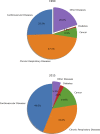The macroeconomic burden of noncommunicable diseases associated with air pollution in China
- PMID: 30998763
- PMCID: PMC6472813
- DOI: 10.1371/journal.pone.0215663
The macroeconomic burden of noncommunicable diseases associated with air pollution in China
Abstract
Background: While a few studies have tried to estimate the economic burden of noncommunicable diseases (NCDs) associated with air pollution, most previous studies have methodological limitations. For example, neither the cost of illness approach nor the value of a statistical life approach accounts for economic adjustment mechanisms (i.e., they do not include substitution of labor lost due to an illness with capital or other workers), and neither approach considers disease impact on physical and human capital. Furthermore, since new evidence shows that air pollution is also linked to diabetes, previous studies did not estimate the economic costs of diabetes associated with air pollution. The total economic costs of NCDs associated with air pollution under a comprehensive framework therefore remained unexplored.
Objectives: This study uses a human capital-augmented production function framework to analyze and estimate the macroeconomic impact of NCDs associated with air pollution in China in 1990-2030 and in 2015-2030. It makes several contributions-beyond those of the extant literature-to understanding the economic burden of NCDs associated with air pollution. It does this by accounting for economic adjustment mechanisms and by incorporating human capital into the model.
Methods: In our framework, aggregate output is produced according to a human capital-augmented production function that accounts for the effects of projected disease prevalence. NCDs associated with air pollution affect the aggregate output through three pathways: 1) Mortality effect-when working-age individuals die from a disease, aggregate output decreases because physical capital is an imperfect substitute for the loss of human capital in the production process. 2) Morbidity effect-when working-age individuals suffer from a disease but do not die from it, their contribution to overall output also decreases depending on disease severity; for example, they might work fewer hours or with lower productivity, or they might retire earlier. We also incorporate age-specific human capital to account for education-related productivity differences between members of different cohorts who are differentially affected by NCDs. 3) Treatment cost effect-when households in which members suffer from a disease use part of their savings to cover the out-of-pocket share of their treatment costs, physical capital accumulation diminishes. Our estimates are based on the recently updated Global Burden of Disease epidemiology data, which identify four pathways through which air pollution affects health: cardiovascular diseases, respiratory diseases, cancer, and diabetes.
Results: Total losses from NCDs associated with air pollution in China in 1990-2030 are estimated to be $1,137 billion (constant 2010 USD) and in 2015-2030 are estimated to be $499 billion (constant 2010 USD). Cardiovascular diseases account for the highest burden, followed by chronic respiratory diseases, diabetes, and cancer. Treatment costs account for nearly 30% of the total economic burden of NCDs associated with air pollution. We also find that the share of economic burden associated with treatment costs is highest for diabetes. This is mainly driven by the fact that, on a per case basis, diabetes has a lower health burden than other diseases associated with air pollution.
Discussion: The NCDs associated with air pollution impose a large economic burden on China.
Conflict of interest statement
The authors have declared that no competing interests exist.
Figures
Similar articles
-
The macroeconomic burden of noncommunicable diseases in the United States: Estimates and projections.PLoS One. 2018 Nov 1;13(11):e0206702. doi: 10.1371/journal.pone.0206702. eCollection 2018. PLoS One. 2018. PMID: 30383802 Free PMC article.
-
A review on Noncommunicable Diseases (NCDs) burden, its socio-economic impact and the strategies for prevention and control of NCDs in India.Indian J Public Health. 2018 Oct-Dec;62(4):302-304. doi: 10.4103/ijph.IJPH_324_16. Indian J Public Health. 2018. PMID: 30539894
-
Health system costs for individual and comorbid noncommunicable diseases: An analysis of publicly funded health events from New Zealand.PLoS Med. 2019 Jan 8;16(1):e1002716. doi: 10.1371/journal.pmed.1002716. eCollection 2019 Jan. PLoS Med. 2019. PMID: 30620729 Free PMC article.
-
The Minderoo-Monaco Commission on Plastics and Human Health.Ann Glob Health. 2023 Mar 21;89(1):23. doi: 10.5334/aogh.4056. eCollection 2023. Ann Glob Health. 2023. PMID: 36969097 Free PMC article. Review.
-
The global impact of non-communicable diseases on healthcare spending and national income: a systematic review.Eur J Epidemiol. 2015 Apr;30(4):251-77. doi: 10.1007/s10654-014-9984-2. Epub 2015 Jan 18. Eur J Epidemiol. 2015. PMID: 25595318 Review.
Cited by
-
Projection of premature mortality from noncommunicable diseases for 2025: a model based study from Hunan Province, China, 1990-2016.PeerJ. 2020 Nov 3;8:e10298. doi: 10.7717/peerj.10298. eCollection 2020. PeerJ. 2020. PMID: 33194444 Free PMC article.
-
Uneven economic burden of non-communicable diseases among Indian households: A comparative analysis.PLoS One. 2021 Dec 10;16(12):e0260628. doi: 10.1371/journal.pone.0260628. eCollection 2021. PLoS One. 2021. PMID: 34890400 Free PMC article.
-
Coronavirus Disease 2019 (COVID-19) Crisis Measures: Health Protective Properties?Medicines (Basel). 2021 Sep 2;8(9):49. doi: 10.3390/medicines8090049. Medicines (Basel). 2021. PMID: 34564092 Free PMC article.
-
The economic burden of COVID-19 in the United States: Estimates and projections under an infection-based herd immunity approach.J Econ Ageing. 2021 Oct;20:100328. doi: 10.1016/j.jeoa.2021.100328. Epub 2021 May 29. J Econ Ageing. 2021. PMID: 34123719 Free PMC article.
-
The global economic burden of chronic obstructive pulmonary disease for 204 countries and territories in 2020-50: a health-augmented macroeconomic modelling study.Lancet Glob Health. 2023 Aug;11(8):e1183-e1193. doi: 10.1016/S2214-109X(23)00217-6. Lancet Glob Health. 2023. PMID: 37474226 Free PMC article.
References
-
- Nemery B, Hoet PH, Nemmar A. The Meuse Valley fog of 1930: an air pollution disaster. The Lancet. 2001;357(9257):704–8. - PubMed
-
- Schrenk HH, Heimann H, Clayton GD, Gafafer W, Wexler H. Air Pollution in Donora, Pa.: Epidemiology of the Unusual Smog Episode of October 1948. Preliminary Report. JAMA. 1950;143(3):323 10.1001/jama.1950.02910380107025 - DOI
-
- Wilkins E. Air pollution and the London fog of December, 1952. Journal of the Royal Sanitary Institute. 1954;74(1):1–21. - PubMed
-
- World Health Organization. Air quality guidelines: global update 2005. Geneva, Switzerland: World Health Organization; 2006.
Publication types
MeSH terms
Grants and funding
LinkOut - more resources
Full Text Sources
Medical




